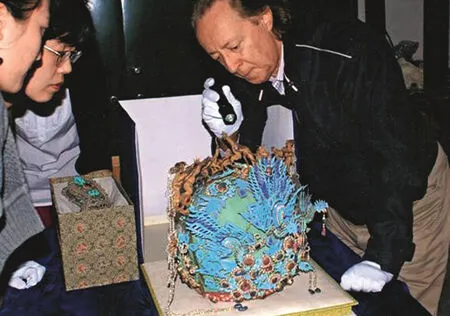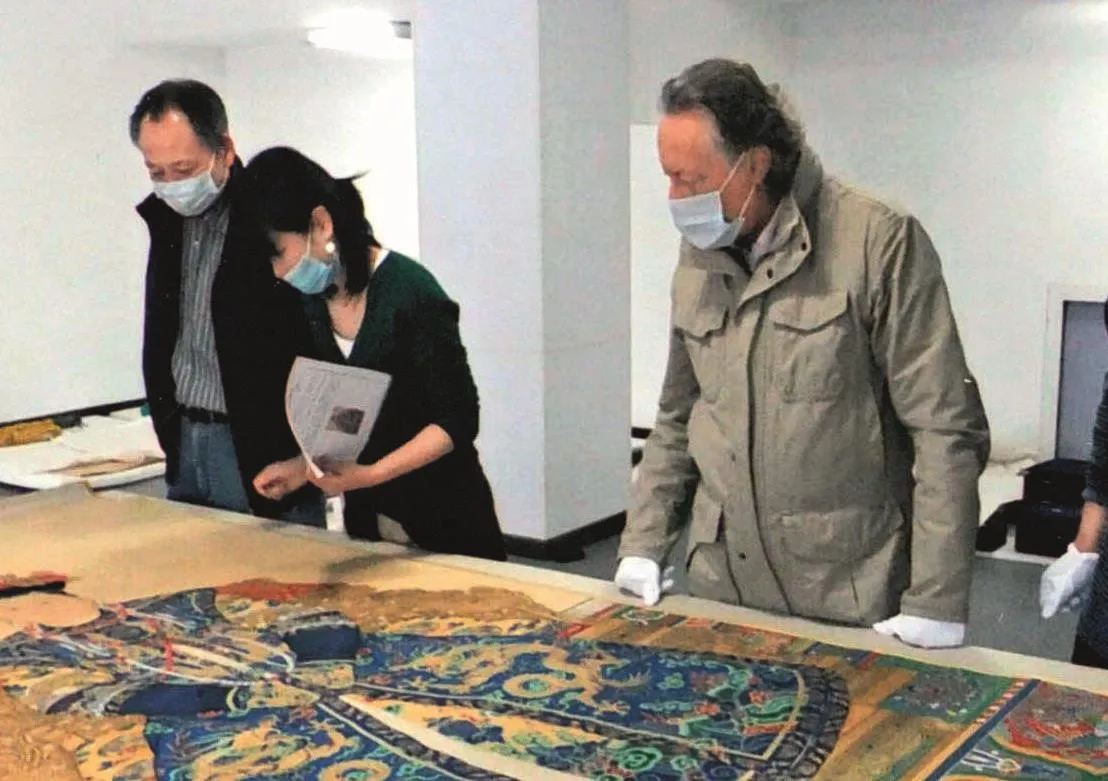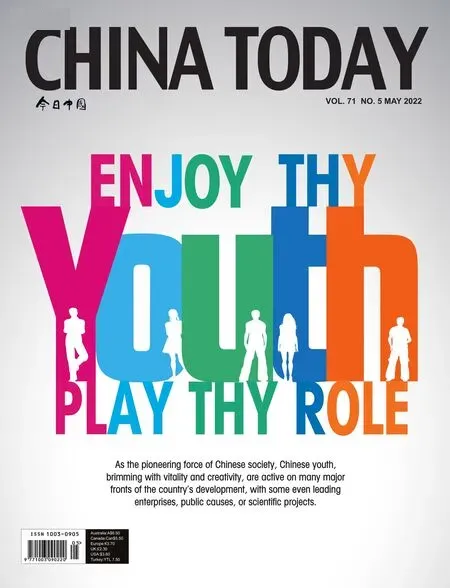Showing China’s Soul
By ADRIANO MÀDARO
Collaborations between Chinese and Italian museums and archaeologists have expanded knowledge beyond borders.

The author Adriano Màdaro examines the ceremonial vest of Emperor Qianlong (1711-1799) in the stock room of the Forbidden City,where precious imperial relics are preserved.
I “met” Lu Xun, perhaps the greatest Chinese writer of the 20th century, when I was 15 years old.Reading “The True Story of Ah Q,” his 1921 masterpiece on rural conditions in the semi-feudal China of the period around the 1911 Revolution, seen through the eyes of a farm laborer, was like stepping through a door into the vast world of Chinese culture.The novella is remarkable not only for the literary content but also for the social, anthropological, historical, and political messages.
My wish to understand China and its civilization had its origin in that book.
For a Western scholar, China offers a scope of boundless research.After studying Chinese history, the more I knew about China and its cultural heritage, the more I was amazed by the ignorance of the Western world.
As a result of Deng Xiaoping’s policy of reform and opening-up rolled out in the late 1970s, we might say the Western business world “re-discovered” China in the last century.However, while burgeoning business quickly opened further doors, it always favored the Western per-spective, which prevented people from understanding the real Chinese cultural power.
I thought that if those businesspeople, who were cultured and sagacious, had dedicated even five percent of their time in China to visiting a museum or the Forbidden City, they could have understood that they were in one of the most civilized centers of the world.
I therefore proposed to an important Italian banking foundation that we hold a series of exhibitions on China,through which we could explain the cultural roots of ancient China not only to entrepreneurs, but to all those who wanted to know about them.The idea was accepted and as curator of the project, I found myself traveling far and wide displayed 300 artifacts of inestimable value.Just to give an idea, they ranged from the Terracotta Warriors of Xi’an in Shaanxi Province, to the throne in the Summer Palace in Beijing, the image of the iconic Tang Dynasty (618-907)camel with musicians playing on its back, the golden crown of Emperor Wanli of the Ming Dynasty who ruled from 1572 to 1620, and the diary of Pu Yi, the last emperor of China.
The exhibitions, which were held in Treviso, near Venice,from October 2005 attracted visitors from all over Italy and abroad, including many school groups.The national council of Chinese state museums called the Treviso exhibitions “the most important project as the window of Chinese culture that has never opened before in Europe.” Four cataloguesin search of museums to illustrate the path of the ancient Silk Road.

1.Adriano Màdaro checks a big porcelain jar from Emperor Wanli’s tomb in Beijing.

2.Adriano Màdaro inspects a phoenix coronet from the tomb of Emperor Wanli’s consort in Beijing.
In 2003, I talked about it with a dear friend in Beijing,Prof.Lü Tongliu, President of the Chinese Academy of International Culture and an Italianist.A committee of Chinese scholars was formed and I began to visit major museums in China to select the precious exhibits.The project included four biennial exhibitions, dividing the ancient Chinese history, from the Qin Dynasty (221-206 B.C.) to the Qing Dynasty (1644-1911), into four historical periods.
Altogether more than 1,200 exhibits came from leading Chinese museums and each exhibition, on average,were published in three languages and the libraries of major Italian museums still have the catalogues.
The initiative did not end there.Given the success of Chinese exhibitions in Italy, archaeologist friends from some Chinese museums asked me to organize exhibitions.The initiative was well received by Italian museums, and the exchange between Chinese and Italian archaeologists was an example of enthusiastic collaboration and mutual learning.
I continued to maintain friendship and collaborations not only with Chinese archaeologists and museums, but also with the publishing houses that published some of my books and with the universities that honored me with thetitle of visiting professor.Working in the cultural field with China is a privilege.The competence and availability of artists, teachers and leaders has increased my affection for the great country.
I also have fond memories of an event I organized in Beijing in 1991 together with the Chinese Academy of International Culture to commemorate the seventh centenary of Marco Polo’s departure from China.We had the participation of scholars from 27 countries, and I proposed to host the three-day symposium in the main hall of the Imperial Ancestral Temple in Beijing, on the east side of the Tian’anmen Gate Tower.Usually that room is reserved for state funeral ceremonies.this great culture has been nurtured.The immense heritage accumulated over the centuries, much of which is still under the ground, waiting to be discovered, is the lintel of China’s wealth; it is the source from which its long history flows.
Chinese archeology, which especially in the last 50 years has had a resounding development, is testimony to the depth of Chinese civilization.Visiting the museums,especially the vaults where the most precious objects are kept, I had the opportunity to understand the originality and value of the cultural forms and expressions.China’s multi-ethnicity has brought diversity to human civilization and enriched it.
I hope that the many incredible archaeological discoveries

3.Adriano Màdaro examines the painting portrait of Empress Xiaozhuang, wife of Emperor Taizong and mother of Emperor Shunzhi,in the stock room of the Forbidden City in Beijing.
In China, Marco Polo is like one of the family.His contribution to the knowledge of China through his wellknown travelogueIl MilioneorThe Travels of Marco Polois fundamental.Through his book China became known in the West in the Middle Ages for its riches as well as culture.Therefore it seemed right to reserve such an important venue to celebrate the occasion.Working with scholars from all over the world in such an august place had a very special meaning for me, especially as I come from the birthplace of Marco Polo, Venice.
China has given me many precious opportunities to whet my cultural interests in close contact with the places where in China, such as the Terracotta Warriors’ pit near Xi’an; the tomb of the Marquise of Dai, a high-ranking official in the Tang Dynasty (618-907), near Changsha, central China’s Hunan Province; and the bronzes and lacquers of the Chu tomb in central China’s Hubei Province, dating back to the Warring States Period (475-221 B.C.), will be followed by many others,testifying how much China has contributed in the cultural field.
- CHINA TODAY的其它文章
- Speed ls Vital in Shanghai’s Fight against COVlD-19
- New Try in Nature and Chinese Tea Culture
- Enjoying the Cherry Blossoms in Full Bloom
- Xi, Mauritian President Exchange Congratulations on 50th Anniversary of Diplomatic Ties
- China’s Top Political Advisor Meets Italian Senate Speaker
- Chinese Premier Stresses Cooperation with Portuguese-Speaking Countries

